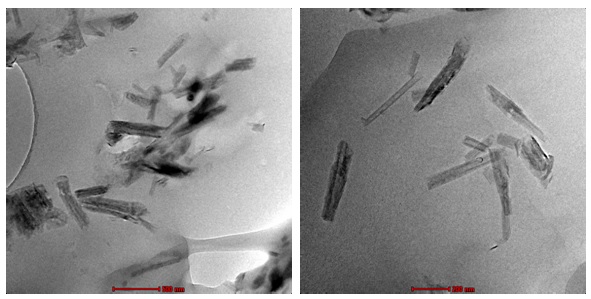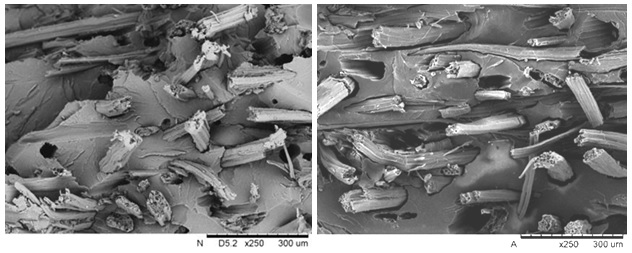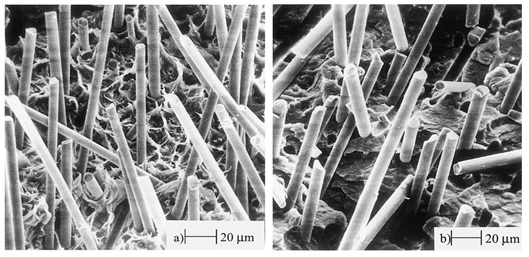Polymer Nanocomposites
A nanocomposite is as a multiphase solid material where one of the phases has one, two or three dimensions of less than 100 nanometers (nm), or structures having nano-scale repeat distances between the different phases that make up the material.[1] In the broadest sense this definition can include porous media, colloids, gels and copolymers, but is more usually taken to mean the solid combination of a bulk matrix and nano-dimensional phase(s) differing in properties due to dissimilarities in structure and chemistry. The mechanical, electrical, thermal, optical, electrochemical, catalytic properties of the nanocomposite will differ markedly from that of the component materials. Size limits for these effects have been proposed,[2].
Nanocomposites are found in nature, for example in the structure of the abalone shell and bone. The use of nanoparticle-rich materials long predates the understanding of the physical and chemical nature of these materials. Jose-Yacaman et al. [3] investigated the origin of the depth of colour and the resistance to acids and bio-corrosion of Maya blue paint, attributing it to a nanoparticle mechanism. From the mid 1950s nanoscale organo-clays have been used to control flow of polymer solutions (e.g. as paint viscosifiers) or the constitution of gels (e.g. as a thickening substance in cosmetics, keeping the preparations in homogeneous form). By the 1970s polymer/clay composites were the topic of textbooks,[4] although the term "nanocomposites" was not in common use.
In mechanical terms, nanocomposites differ from conventional composite materials due to the exceptionally high surface to volume ratio of the reinforcing phase and/or its exceptionally high aspect ratio. The reinforcing material can be made up of particles (e.g. minerals), sheets (e.g. exfoliated clay stacks) or fibres (e.g. carbon nanotubes or electrospun fibres). The area of the interface between the matrix and reinforcement phase(s) is typically an order of magnitude greater than for conventional composite materials. The matrix material properties are significantly affected in the vicinity of the reinforcement. Ajayan et al. [1] note that with polymer nanocomposites, properties related to local chemistry, degree of thermoset cure, polymer chain mobility, polymer chain conformation, degree of polymer chain ordering or crystallinity can all vary significantly and continuously from the interface with the reinforcement into the bulk of the matrix.
This large amount of reinforcement surface area means that a relatively small amount of nanoscale reinforcement can have an observable effect on the macroscale properties of the composite. For example, adding carbon nanotubes improves the electrical and thermal conductivity. Other kinds of nanoparticulates may result in enhanced optical properties, dielectric properties, heat resistance or mechanical properties such as stiffness, strength and resistance to wear and damage. In general, the nano reinforcement is dispersed into the matrix during processing. The percentage by weight (called mass fraction) of the nanoparticulates introduced can remain very low (on the order of 0.5% to 5%) due to the low filler percolation threshold, especially for the most commonly used non-spherical, high aspect ratio fillers (e.g. nanometer-thin platelets, such as clays, or nanometer-diameter cylinders, such as carbon nanotubes).

TEM micrograph of MMT filled PLA/NR composites
Polymer-matrix nanocomposites
In the simplest case, appropriately adding nanoparticulates to a polymer matrix can enhance its performance, often in very dramatic degree, by simply capitalizing on the nature and properties of the nanoscale filler [13] (these materials are better described by the term nanofilled polymer composites [13]). This strategy is particularly effective in yielding high performance composites, when good dispersion of the filler is achieved and the properties of the nanoscale filler are substantially different or better than those of the matrix, for example, reinforcing a polymer matrix by much stiffer nanoparticles [14][15] of ceramics, clays, or carbon nanotubes. Alternatively, the enhanced properties of high performance nanocomposites may be mainly due to the high aspect ratio and/or the high surface area of the fillers,[16][17] since nanoparticulates have extremely high surface area to volume ratios when good dispersion is achieved.
Nanoscale dispersion of filler or controlled nanostructures in the composite can introduce new physical properties and novel behaviours that are absent in the unfilled matrices, effectively changing the nature of the original matrix [13] (such composite materials can be better described by the term genuine nanocomposites or hybrids [13]). Some examples of such new properties are fire resistance or flame retardancy [18] and accelerated biodegradability.

SEM micrograph of kenaf fibre reinforced composites specimens before and after hygrothermal aging

SEM micrographs taken from the fracture surface of untreated short glass fibre–PBT in (a) As-received condition and (b) Hygrothermally aged states, respectively.
